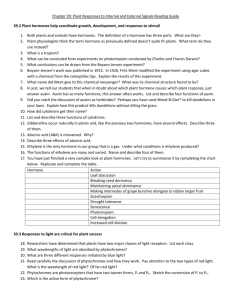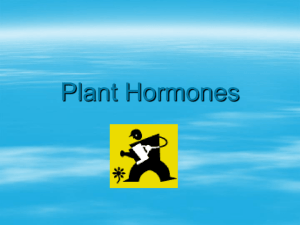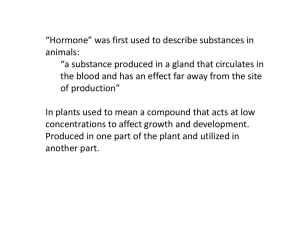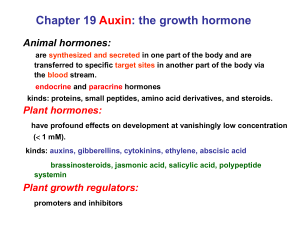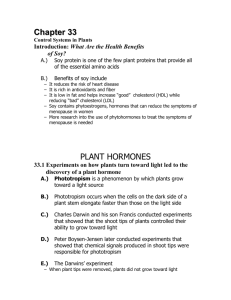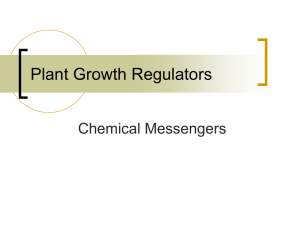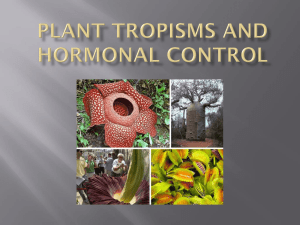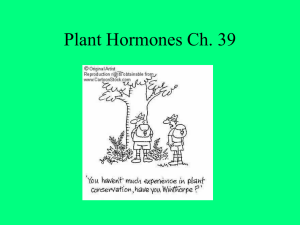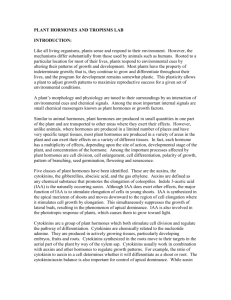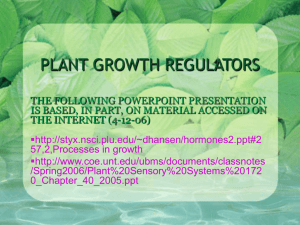Plant Hormone Advertising Project: Biology Assignment
advertisement
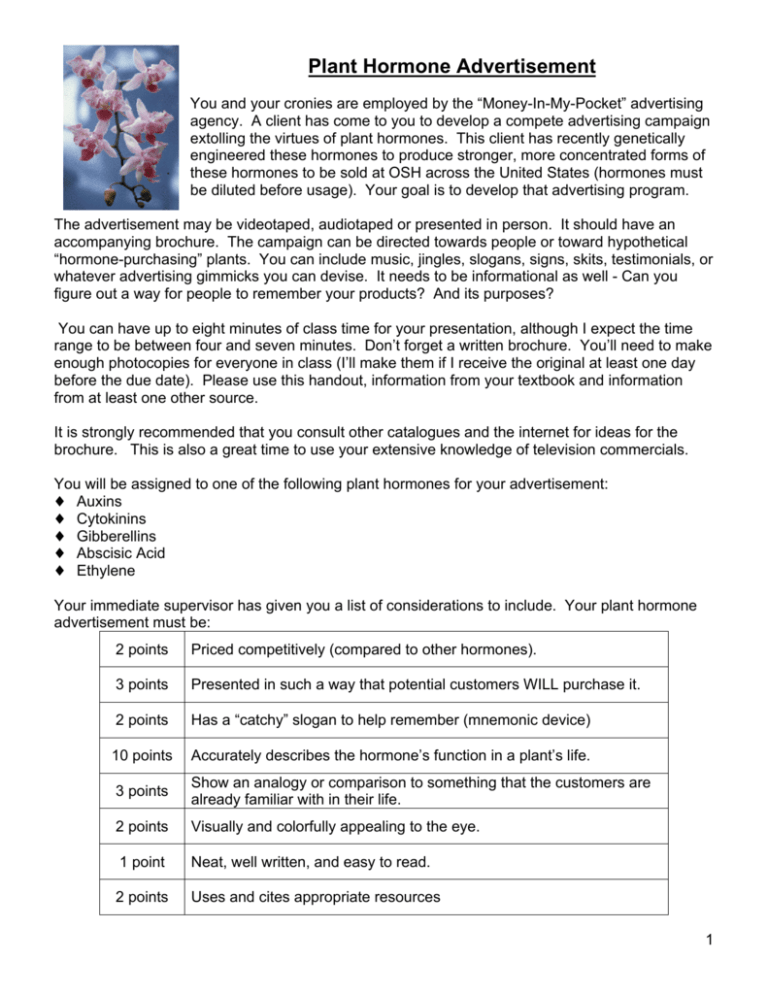
Plant Hormone Advertisement You and your cronies are employed by the “Money-In-My-Pocket” advertising agency. A client has come to you to develop a compete advertising campaign extolling the virtues of plant hormones. This client has recently genetically engineered these hormones to produce stronger, more concentrated forms of these hormones to be sold at OSH across the United States (hormones must be diluted before usage). Your goal is to develop that advertising program. The advertisement may be videotaped, audiotaped or presented in person. It should have an accompanying brochure. The campaign can be directed towards people or toward hypothetical “hormone-purchasing” plants. You can include music, jingles, slogans, signs, skits, testimonials, or whatever advertising gimmicks you can devise. It needs to be informational as well - Can you figure out a way for people to remember your products? And its purposes? You can have up to eight minutes of class time for your presentation, although I expect the time range to be between four and seven minutes. Don’t forget a written brochure. You’ll need to make enough photocopies for everyone in class (I’ll make them if I receive the original at least one day before the due date). Please use this handout, information from your textbook and information from at least one other source. It is strongly recommended that you consult other catalogues and the internet for ideas for the brochure. This is also a great time to use your extensive knowledge of television commercials. You will be assigned to one of the following plant hormones for your advertisement: ♦ Auxins ♦ Cytokinins ♦ Gibberellins ♦ Abscisic Acid ♦ Ethylene Your immediate supervisor has given you a list of considerations to include. Your plant hormone advertisement must be: 2 points Priced competitively (compared to other hormones). 3 points Presented in such a way that potential customers WILL purchase it. 2 points Has a “catchy” slogan to help remember (mnemonic device) 10 points Accurately describes the hormone’s function in a plant’s life. 3 points Show an analogy or comparison to something that the customers are already familiar with in their life. 2 points Visually and colorfully appealing to the eye. 1 point Neat, well written, and easy to read. 2 points Uses and cites appropriate resources 1 Plant Hormones General Information: Hormone = A compound produced by one part of an organism that is transported to other parts where it triggers a response in target cells and tissues. Plant hormones help coordinate growth, development and responses to environmental stimuli. Plant hormones control plant growth and development by affecting division, elongation, and differentiation of cells. 1. Auxin = A hormone that promotes elongation of young developing shoots. The natural auxin found in plants is a compound named indoleacetic acid (IAA). The apical meristem is a major site of auxin production. Other effects of auxin include affecting secondary growth by inducing vascular cambium cell division and differentiation of secondary xylem, promoting formation of adventitious roots, promoting fruit growth in many plants, and use as herbicides. Auxins are implicated in tropism responses such as phototropism and gravitropism. Shoots grow towards the light (positive phototropism) and against gravity (negative geotropism). Auxin is produced in a higher concentration on the side away from the light. This is because auxin causes an increase in cell size and this causes the plant to bend towards the light (causes elongation in tips of shoots and roots). This increases the efficiency of photosynthesis. 2. Cytokinins = Modified forms of adenine that stimulate cytokinesis. Cytokinins function in several areas of plant growth: cell division and differentiation, apical dominance, and anti-aging hormones. a. Control cell division and differentiation: Cytokinins move from the roots to target tissues by moving up in the xylem sap. They stimulate RNA and protein synthesis. The new proteins produced by stimulation of RNA appear to be involved in cell division. Cytokinins, in conjunction with auxin, control cell division and differentiation: i. Stem parenchyma cells cultured without cytokinins grow very large and do not divide ii. Cytokinins added alone have no effect on cells grown in tissue cultures iii. Equal concentrations of cytokinins and auxins stimulate cells to grow and divide iv. More cytokinin than auxin causes shoot buds to develop v. More auxin than cytokinin causes roots to form b. Control of apical dominance: Auxins and cytokinins are antagonistic in the control of apical dominance. Auxins inhibit the growth of axillary buds, and cytokinins promote their growth. Auxin stimulates lateral root formation while cytokinins restrain it. This stimulation-inhibition action may help balance plant growth since an increase in the root system would signal the plant to produce more shoots. 2 c. Cytokinins as anti-aging hormones: cytokinins can retard aging of some plant organs and may slow leaf deterioration on plants. Detached plant leaves dipped in a cytokinin solution stay green longer. 3. Gibberellins = influence stem elongation, as well as flowering and fruit development. Gibberellins are also involved in the germination of seeds in many plants. a. Stem elongation: giberellins are produced primarily in roots and young leaves. They stimulate growth in leaves and stems but show little effect on roots, stimulate cell division and elongation in stems, possibly in conjunction with auxin, and cause bolting (rapid growth of floral stems, which elevates flowers). This picture demonstrates the action of gibberellin (GA) on developmental processes: Treatment of pumpkin seedlings with GA results in an increase of hypocotyl length (see second plant from left). On the other hand application of LAB 150978, an inhibitor of GA-biosynthesis, results in dwarf plants (third plant from left). However, such dwarfs can be restored by additional application of GAs (fourth plant from left). b. Fruit Growth: fruit development is controlled by both gibberellins and auxin. In some plants, both must be present for fruit set. c. Germination: the release of gibberrellins signals seeds to break dormancy and germinate. A high concentration of gibberellin is found in many seeds, especially in the embryo. In breaking both seed dormancy and apical bud dormancy, gibberellins act antagonistically with abscisic acid, which inhibits plant growth. 4. Abscisic Acid (ABA) is produced in the terminal bud and helps prepare plants for winter by suspending both primary and secondary growth. ABA promotes abscission of leaves and fruits (in contrast to auxin, which inhibits abscission). It is, in fact, this action that gave rise to the name abscisic acid. The dropping of leaves in the autumn is a vital response to the onset of winter when ground water is frozen, and thus cannot support transpriation, and snow load would threaten to break any branches still in leaf. ABA directs leaf primordia to develop scales that protect dormant buds and it inhibits cell division in vascular cambium. In most cases, the ratio of ABA:gibberellins determines whether seeds remain dormant or germinate. In desert plants, seeds germinate when ABA is washed out of the seeds. ABA also acts as a stress hormone, closing stomata in times of water-stress thus reducing transpirational water loss. 5. Ethylene = a gaseous hormone that diffuses through air spaces between plant cells. Ethylene can also move in the cytosol, traveling from cell to cell in the phloem. High auxin concentrations induce release of ethylene, which acts as a growth inhibitor. a. Fruit ripening: during fruit ripening, ethylene triggers senescence, and then the aging cells release more ethylene. The signal to ripen spreads from fruit to fruit since ethylene is a gas. b. Leaf abscission is an adaptation that prevents trees from collapsing/dying during water when roots cannot absorb water from the frozen ground and snow weighs down branches. Before abscission, the leaf’s essential elements are shunted to storage tissues in the stem from which they are recycled to new leaves in the spring. Environmental stimuli for leaf abscission are shortening of days and cooler temperatures. 3 Plant Hormone Advertisement Rubric Possible Points Points Earned Guidelines 2 points Priced competitively (compared to other hormones). 3 points Presented in such a way that potential customers WILL purchase it. 2 points Has a “catchy” slogan to help remember (mnemonic device) 10 points Accurately describes the hormone’s function in a plant’s life. 3 points Show an analogy or comparison to something that the customers are already familiar with in their life. 2 points Visually and colorfully appealing to the eye. 1 point Neat, well written, and easy to read. 2 points Uses and cites appropriate resources Total: /25 Plant Hormone Advertisement Rubric Possible Points Points Earned Guidelines 2 points Priced competitively (compared to other hormones). 3 points Presented in such a way that potential customers WILL purchase it. 2 points Has a “catchy” slogan to help remember (mnemonic device) 10 points Accurately describes the hormone’s function in a plant’s life. 3 points Show an analogy or comparison to something that the customers are already familiar with in their life. 2 points Visually and colorfully appealing to the eye. 1 point Neat, well written, and easy to read. 2 points Uses and cites appropriate resources Total: /25 4
